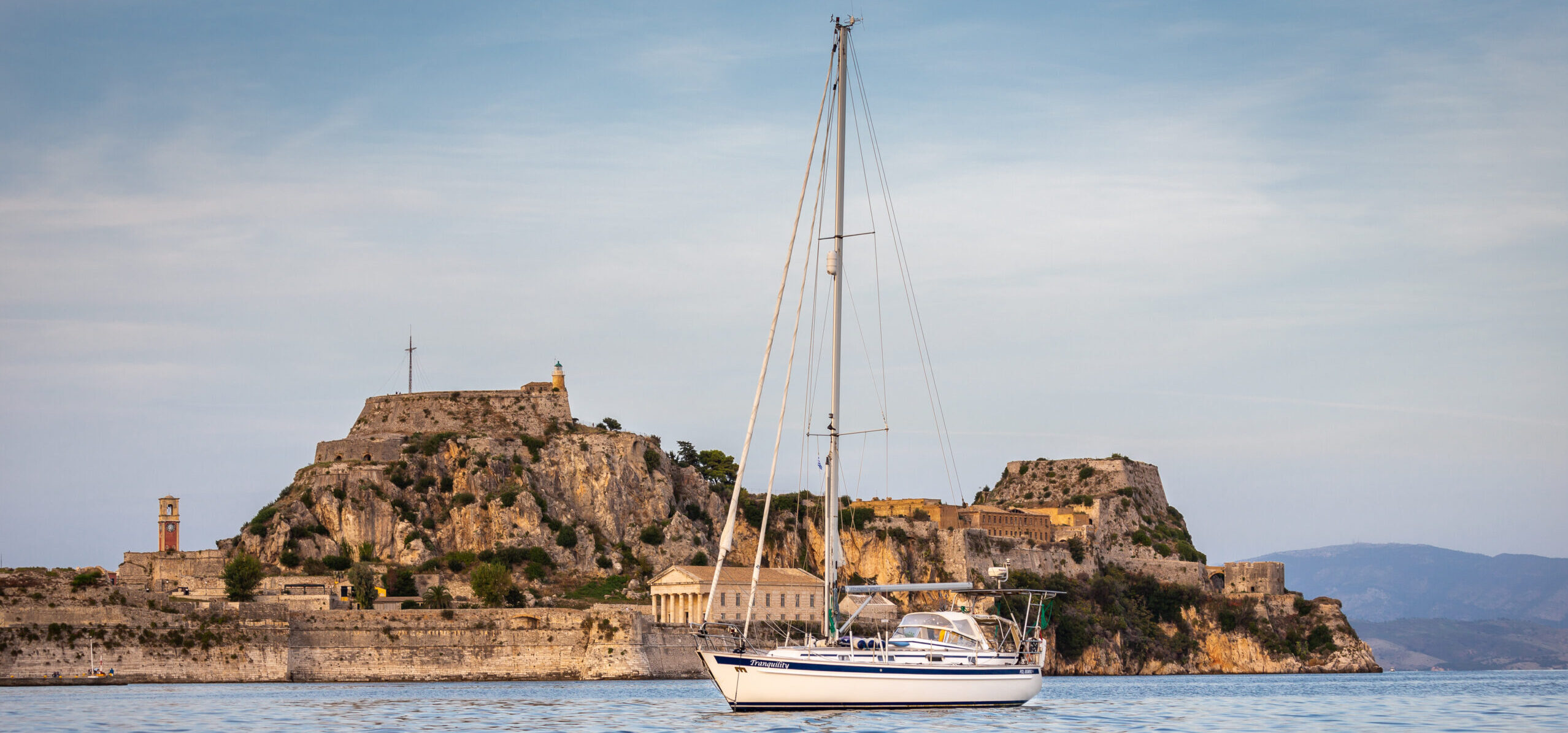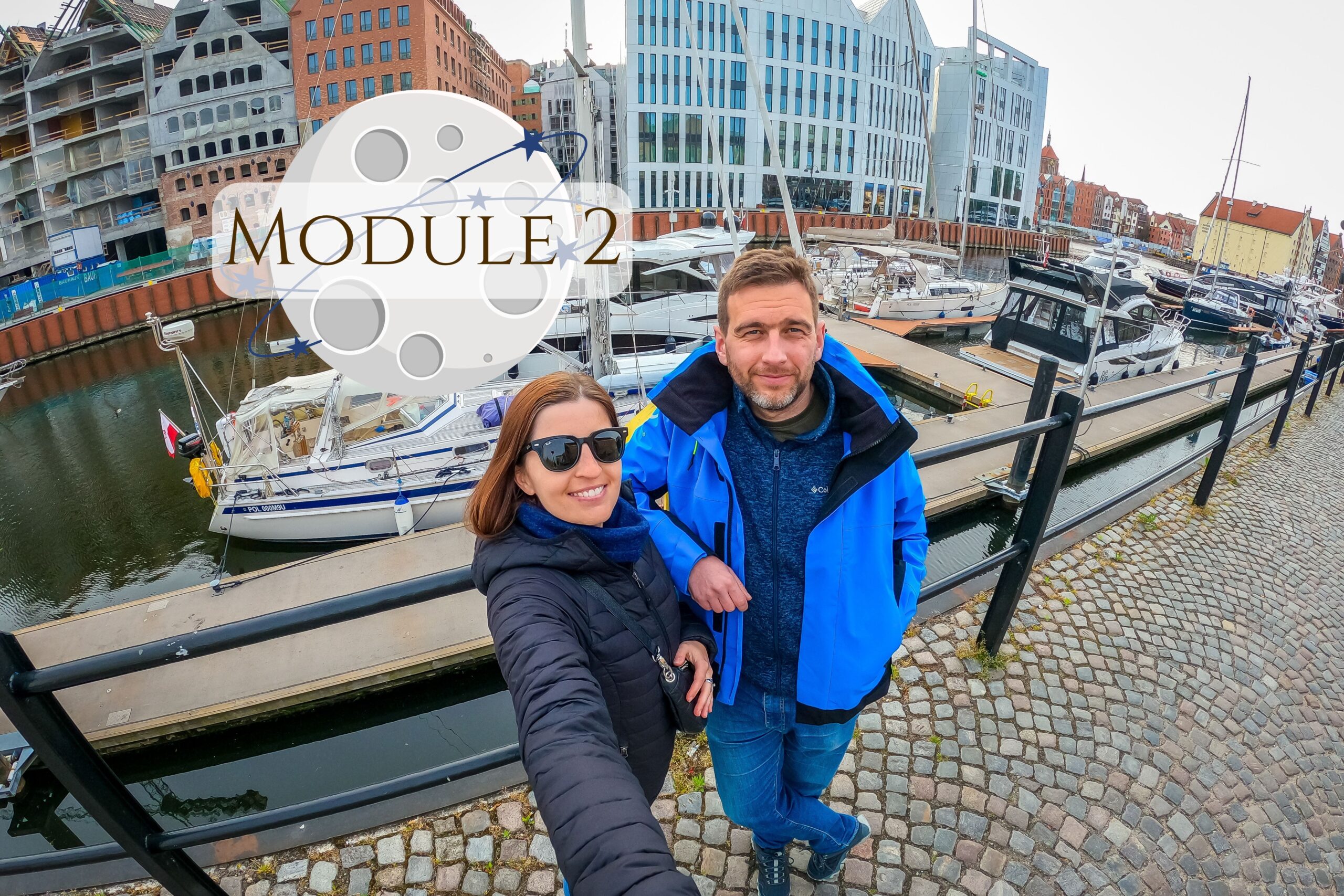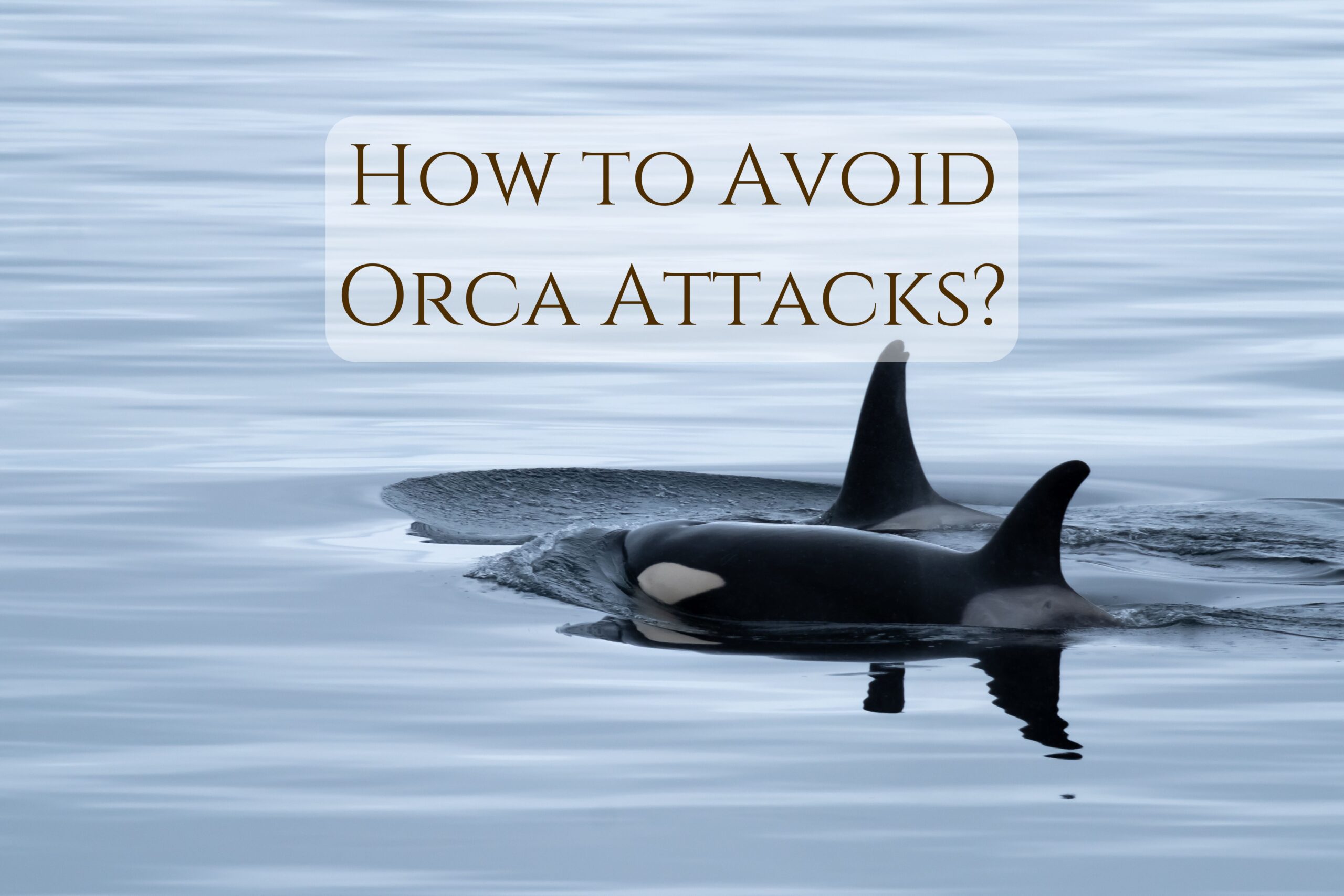Refit in Gdańsk, Poland
After bringing our yacht to Poland, Marina Przełom in Gdańsk becomes our temporary home. We assume that we need about a month to prepare the boat for sailing in Poland and further cruise around Europe. Additionally, we want to take advantage of the proximity to home and move in. Staying in Poland makes moving in process much easier to organize and it’s financially more efficient. Sending all our belongings to another country would be much more problematic. Even though we try not to accumulate too many things around us, as we have learned from countless relocations (I lost count after 15), it turns out that our car is filled to the roof. Fortunately, the marina has a storage room where we can leave everything while we work on the yacht.
Basically all systems need an overhaul. Apart from the obvious things that need to be done before each season, we need to decide which projects should be done before departure and which can wait. We do not want and cannot get involved in long-term renovations in Poland. It would delay our start, and it is already spring. Moreover, many parts and equipment are not immediately available and the waiting time can be up to several weeks. And most importantly – we want to spend one season on the yacht to verify what we really need, what requires modification, replacement or refitting. Writing this text from Greece, I can definitely say that it was a good decision.
But let’s get back to Poland. Another reason why we do not want to do a large renovation here is that we are in a hurry to get to Greece rather than to stay in the shipyard for many months. A yacht doesn’t sail around the world all at once. The plan for the coming years covers Europe, so we can spread modernization and add additional equipment over time. And last, perhaps the most important – our Malo is in such good condition that it does not actually need any serious renovation, we can cast the lines and sail, just like we did when sailing from Sweden to Poland.
Upgrade of electrical system
Nevertheless, in Poland we decide to convert the electrical installation from AGM batteries to lithium ones and to enlarge the battery bank. This is the first step to the self-sufficiency of the boat. I will not write here about the details of this installation – there will be a separate post about it.
Ground tackle
Knowing that we will spend most of our life at anchor, we also decide to replace it – from a 20-kilogram Bruce anchor to a 33-kilogram modern Vulcan plow anchor.
We ordered it to Sweden because there was a problem with its availability in Poland and it was more expensive. And our new chain, for exactly the same reason, is already waiting for us in… Spain! Here’s a piece of advice – when refitting your yacht, it’s worth checking prices not only in Poland or in the country you are in. We have often found out that the price with international shipping was more attractive than from a local dealer.
Since we are talking about the anchor, or rather the entire ground tackle, it is worth noting that it is as important to us as an insurance policy or a good life raft. That’s why we have a heavy, large and the best anchor on the market, which ensures a good night’s sleep even in difficult conditions.
Safety equipment
The availability of a good life raft also proves to be a problem. We are in contact with the manufacturer’s representatives throughout Europe, only to find out at the end of the day that everyone is waiting for the same, delayed container from Thailand.
We are completing safety equipment.
Electronics and navigation system upgrade
We are also expanding the electronics and navigation system. We are installing an AIS device that will allow us to track other traffic and be seen at sea. I wrote in a previous post, how useful would it be while sailing through the Baltic Sea from Sweden. We are building a NMEA 2000 network and connecting it to the existing Raymarine SeaTalk. These are networks connecting all instruments, navigation, autopilot, etc. – the brain of the boat.
Boat registration and re-naming
We also take care of all formalities, such as registering a yacht under the Polish flag and registering radio transmitters. Of course, we are also changing the name of the boat to “Tranquility”.
During our stay in Gdańsk, we also perform many smaller, minor works and alterations. But as soon as we complete priority ones, it’s time to set off.
Visiting Gdańsk city
When working on a yacht all day long, it’s easy to forget why you’re doing it. So we try to take some time off and explore the area. As we come from a completely different part of Poland, there are many places we are visiting for the first time. First of all, we visit the beautiful, historic port city of Gdańsk, which was rebuilt after World War II in the style that dominated in the city’s golden era. The rows of colorful, soaring tenement houses look phenomenal. On another occasion, we also visit Westerplatte – the place where the first shots were fired, starting World War II. Our loved ones are visiting us in Gdańsk to see our new home!
Provisioning
When the time for handing over the mooring lines is approaching and the work is coming to an end, we spend 2 days on provisioning. Taking advantage of the fact that we have a car, we buy as much non-perishable food as possible. One of the criteria we had for choosing a yacht was its storage space. I must admit that after a year I still think that this is one of many great advantages of Malo 39. Thanks to this, purchases made in Poland (vacuum-packed in case of food) are still in use today and there is no sign of them running out. We saved some money this way because the same things in Western Europe would have cost us more. We also do most of our provisioning online, which pushes the nearest parcel locker to its limits.
Depatrute from Gdańsk
Without planning it, the date of departure from Marina Przełom falls on my birthday and it is a very nice start to our cruise. Since we are already in Gdańsk, it would be a pity not to spend the last night in the marina in the very center of the city, under the Green Gate when sailing in Poland. Even though this involves sailing up the Vistula along the industrial and unattractive transshipment quays of the Gdańsk harbor, a stop in the heart of the old town compensates for this.
The next day, like the buccaneer Jan Marten, the hero of Janusz Meissner’s book “Zielona Brama”, which we read in our youth, we set off on the journey of a lifetime from the same Green Gate.
Hel and Seal Sancturay – Sailing in Poland
There is a short sail ahead of us – less than 20 nautical miles to Hel. Even though we know Hel well from our childhood holidays, it’s nice to come back here.
When sailing in Poland, a must-see on the coastline’s map is Hel with its Seal Sanctuary. It deals with the restoration and protection of gray seals in the southern Baltic Sea. The sanctuary examines, among others: behavior of seals, feeding methods and their diet, age, migration routes, tissue poisoning with toxic substances, and also determines the most important threats and causes of death of these animals. A visit to this place allows us to gain knowledge about these amazing animals and, unfortunately, realize how much we harm them. One of the memorable exhibits is a pile of coins that rescuers pulled from the stomach of a dead seal. I always think about this when I see people throwing coins for good luck into various pointless places.
In the Seal Sanctuary you can also admire the seals that are currently under the care of the facility. Some will be released into the wild when they recover, but there are also some that will stay here forever because they would not survive in their natural environment.
It is always worth visiting places such as the Seal Sanctuary in Hel. However, I always advice to verify whether they really serve animals or were set up as tourist attractions that profit from keeping animals, often in unsuitable conditions. Unfortunately, there are a lot of the latter in the world. When traveling, we always try to verify if we are not contributing to the suffering of animals, regardless of whether it is about elephants in Sri Lanka, cheetah orphanages in Zanzibar or a seal aquarium. Sometimes you have to do a little digging, but in the case of the Seal Sanctuary in Hel, you don’t have to – this place really cares about animals!
Even though it is already May and spring is in full swing, Hel is still asleep and resembles a ghost town. We end the day at a shanty evening in the famous Captain Morgan tavern and in the morning we set off further.
Sailing in Poland – next stops
The next leg is not much longer – from Hel to Władysławowo. In Władysławowo we moor in the fishing port, next to a small quay for yachts.
Unfortunately, the Polish coast is not one of the most interesting sailing areas in the world. We lack natural bays and most ports are in estuaries. Although marinas with modern infrastructure are being built, there are still few of them. Most of them however are fishing ports – very charming, but not very convenient to sailors like us.
The same applies to Ustka and Kołobrzeg, which are the next stops during our sailing along the Polish coast.
There are numerous military training areas that you encounter while sailing in Poland. It is sailor’s responsibility to check whether such zones are active or it is possible to sail through them. Unfortunately, it is not as well organized as in aviation, where in one global NOTAM (Notice to Airmen) system, you can find information about any airport, zone or other danger in just a few seconds. So, in order not to become a training target accidentally, we grab the phone and determine which route we can sail.
In Ustka we meet another sailor who also sets off on a similar journey. When we leave, he gives us a “fishing for dummies” kit so that we don’t die of hunger along the way. Unfortunately, the equipment itself won’t catch fish, so we still have plenty to learn 🙂
In a few days in Szczecin, we will meet more people who are going to warmer waters.
Stop in Szczecin and another upgrades
Solar arch project
But we won’t leave Polish waters anytime soon! Since arriving in Poland, we have been preparing the design of the solar arch to install on the stern. Such stainless steel frames are not only used to install solar panels, but also for hanging a dinghy under them, mounting a radar antenna, etc. Our new electrical installation in Gdańsk also needs a renewable power source, so this project is quite a priority. We look through lots of photos and layouts, measure our stern to decide what we have space for, what the assembly possibilities and limitations are, and what will fit best into our boat while fulfilling its main purpose. Welding an arch is one of those jobs on a yacht that you cannot do yourself, unless you are a specialist in welding stainless steel.
So we make an appointment with the contractor in Szczecin, order solar panels and prepare for a few days’ stop.
Sailing in Poland – reaching Szczecin
However, before we reach Szczecin, we pass the busy port of Świnoujście and the famous Stawa Młyny. It’s a historical navigation sign in the shape of a windmill at the entrance to Świnoujście. It can be found on all postcards from the city. We sail up the Odra River through narrow waterways. It is not pleasant sailing. The waterways are narrow, surrounded by shallows, overgrown with bushes, which are a paradise for insects. We move slowly to the rhythm of the engine. However, the tiny marina where we are supposed to work turns out to be quite charming. It is located far from the city, there is a lot of nature around. In the evenings, a fox walks on the pier next to it, unsuccessfully trying to hunt a much larger heron.
As it is usually the case with boat work that is arranged remotely, nothing is as it should be on site. It turns out that we have to measure the stern again and change the design a bit. Few days in Szczecin sounds like a wishful thinking. The installation is not going as planned, we have long delays, and we constantly have to make corrections. The final welds are made on the arch which is already installed on the boat. As you might guess, is far from ideal. Unfortunately, after a year of use, we see that this project did not work as planned. Sooner rather than later we will have to redo it.
Finally on the way
Time in the reeds of Szczecin is long, the city is not attractive and the spirits are low. Therefore, when we finally leave Szczecin after 10 days, on 2nd of June, our joy knows no limits. We sail along the waterways to Trzebież, a small town close to the German border. There we refuel the yacht, do some last-minute shopping, eat the last Polish fried fish. Then, we finally feel that we are setting off on the cruise of a lifetime.
Even though we had set off a month earlier, we had not yet felt like we were on the way. It was probably because we were sailing in Poland, our own country, so it was difficult to feel like we were on the road. Now we finally feel it.
Sailing in Poland coming to an end
Water skiers attack
The next morning we leave Trzebież and sail through the Szczecin Lagoon straight to Germany – this time we bypass Świnoujście. Poland does not say goodbye to us nicely. Insects sitting on the still surface of the water (later I found out that they were water skiers) jump up and cover whole cockpit enclosure. There are thousands of them and nothing helps. Killing them makes stains on our cockpit enclosure that we will never get rid of. We are losing the unequal fight. We will find insects in various corners of the boat for at least a month, despite regular washing and cleaning. It’s good that we closed the companionway in time. I can’t imagine what would have happened if they had gotten below deck. The photos below are only for the brave:
So, covered in insects, nervously running around the boat with a vacuum cleaner to suck in as many of them as possible (because that turned out to be the most effective method), we don’t even notice that we have crossed the Polish-German border. So it happened, we set sail for good, we left Poland, with unknown horizons ahead of us.
Sailing in Poland – summary
How will we sum up our cruise along the Polish coast? The Polish Baltic coast is still not our favorite cruising area, nothing has changed in this respect. But we visited many known and unknown cities and towns. We went to places where we spent holidays as children, where we used to spend summer camps. I saw my beloved lighthouses. We met friends. We couldn’t have dreamed of a better start to our trip.
What’s next?
In module 3 you will sail with us further West. We will take you to the V2 rocket factory – Peenemunde. We will check out seals in their natural environment and ride bikes around Hiddensee. Then it’s time to leave the Baltic Sea through the Kiel Canal, having previously watched the Ocean Race literally from the front row.




























2 Responses
Cudowne zdjęcia 😍😍😍
Dziękuję! 🙂